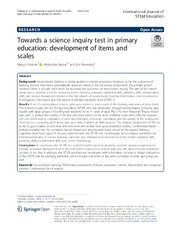Приказ основних података о документу
Towards a science inquiry test in primary education: development of items and scales
| dc.creator | Pedaste, Margus | |
| dc.creator | Baucal, Aleksandar | |
| dc.creator | Reisenbuk, Elle | |
| dc.date.accessioned | 2021-10-12T13:31:40Z | |
| dc.date.available | 2021-10-12T13:31:40Z | |
| dc.date.issued | 2021 | |
| dc.identifier.issn | 2196-7822 | |
| dc.identifier.uri | http://reff.f.bg.ac.rs/handle/123456789/3312 | |
| dc.description.abstract | Background Inquiry-based learning is widely applied in science education; however, so far, the outcomes of learning process have been systematically assessed mainly at the secondary school level. For primary school students, there is no valid instrument for assessing the outcomes of their science inquiry. The aim of the current study was to develop a test for assessing science learning outcomes (analytical skills, planning skills, interpretation skills, and science knowledge) related to the five phases of inquiry-based learning (Orientation, Conceptualization, Investigation, Conclusion, and Discussion) at primary education level (ISCED 1). Results A set of contextualized science tasks was created to assess each of the learning outcomes at three levels. The Science Inquiry Test for Primary Education (SIT-PE test) was developed through several phases, including pilot studies with large groups of fourth-grade students (10 to 11 years of age). The 1 PL Item Response Theory model was used to analyze the quality of the test and items based on the test's reliability score, item difficulty measure, infit and outfit indices, estimation of item discrimination, item-scale correlation, and the quality of the scoring key. The final test, consisting of 24 items, was used with a sample of 1868 students. The analysis showed the SIT-PE test to be of good quality on test level and item level and to also have good predictive validity. Confirmatory factor analysis revealed that the correlated factors model and second-order factor model of the science learning outcomes both had a good fit to data collected with the SIT-PE test. Confirmatory factor analysis confirmed the multidimensionality of science learning outcomes and validated four dimensions of the model: analytical skills, planning skills, interpretation skills, and science knowledge. Conclusions In conclusion, the SIT-PE test could be further used for assessing students' inquiry competence in primary education. However, it could be even further improved in several ways and this study provides guidelines on how to do that. In addition, the SIT-PE provides test developers with information on how to design derivations of the SIT-PE test for assessing particular science inquiry outcomes or the same outcomes in older age groups as well. | en |
| dc.publisher | Springer, New York | |
| dc.relation | Estonian Ministry of Education and ResearchMinistry of Education and Research, Estonia | |
| dc.relation | Estonian Research CouncilEstonian Research Council [IUT34-6] | |
| dc.relation | European Social Fund (ESF) | |
| dc.rights | openAccess | |
| dc.rights.uri | https://creativecommons.org/licenses/by/4.0/ | |
| dc.source | International Journal of Stem Education | |
| dc.subject | Science | en |
| dc.subject | Primary education | en |
| dc.subject | Performance assessment | en |
| dc.subject | Item response models | en |
| dc.subject | Inquiry-based learning | en |
| dc.subject | Confirmatory factor analysis | en |
| dc.subject | Assessment | en |
| dc.title | Towards a science inquiry test in primary education: development of items and scales | en |
| dc.type | article | |
| dc.rights.license | BY | |
| dc.citation.issue | 1 | |
| dc.citation.other | 8(1): - | |
| dc.citation.rank | aM21~ | |
| dc.citation.volume | 8 | |
| dc.identifier.doi | 10.1186/s40594-021-00278-z | |
| dc.identifier.fulltext | http://reff.f.bg.ac.rs/bitstream/id/1888/3309.pdf | |
| dc.identifier.scopus | 2-s2.0-85102677898 | |
| dc.identifier.wos | 000630948900002 | |
| dc.type.version | publishedVersion |

